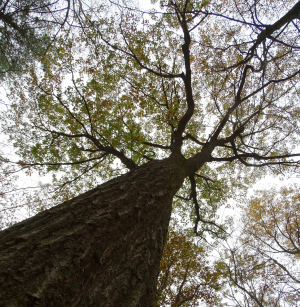You are here
Press Release: High-Tech Tree Tells Climate Stories Online
FOR IMMEDIATE RELEASE
Contacts: Clarisse Hart, Harvard Forest Outreach Director, 978-756-6157; hart3@fas.harvard.edu
Kate Petersen, NAU Ecoss Coordinator, 928-523-2982; kate.petersen@nau.edu
High-Tech Tree Tells Climate Stories Online
Wired red oak is first of its kind in North America

As trees across the U.S. continue their picturesque march toward autumn, one 100-year-old oak tree in Massachusetts is attracting a crowd of admirers online. The tree is a scientific wonder—not because of its unique looks or a special way it grows, but because of its ability to share information online.
The idea for the Harvard Forest Witness Tree, a social media outreach project led by post-doctoral fellow Tim Rademacher of Northern Arizona University and Harvard University, began as a public outreach component of a study investigating the effect of environmental changes on wood growth, funded by the National Science Foundation.
“The tree is wired with sensors that measure its growth, sap flow, local climate, and other factors in real-time,” says Rademacher. “Because we were measuring these things anyway, we thought, why not use the data to give the tree a voice?”
Since the tree’s Twitter account launched in July 2019, it has attracted over 7,700 followers, who regularly share the tree’s messages and ask it questions (which it answers). The Twitter account – and as of this week, the Facebook account – for the Witness Tree is the first of its kind in North America.
Helping a tree to trend on social media was a process two years in the making. In summer 2018 and 2019, Rademacher worked at Harvard Forest with undergraduate interns Kyle Wyche of University of Pittsburgh and Shawna Greyeyes of Coconino Community College to deploy the sensors and write analytical code that would connect data streams from the tree to public messages on Twitter and Facebook.
Wyche helped to write and test some of the first computer code for the Witness Tree, and says he is thrilled it has now come to fruition online. He notes the team made a choice early on about the tree’s name – “a witness tree” instead of “the witness tree” – signifying that this tree is one of trillions experiencing environmental change. “We want people to understand that every tree bears witness to the changing world,” says Wyche.
Greyeyes worked on message coding and a website for the tree in summer 2019. “I kept several things in mind while creating the messages,” she says. “We went with a first-person narrative, with context and visuals that are hopefully easy to understand and connect with.” This year, Greyeyes is a SEEDS SPUR Fellow for the Ecological Society of America and will present her research on the Witness Tree at the society’s national conference in summer 2020.
Andrew Richardson, Professor at Northern Arizona University’s Center for Ecosystem Science and Society, and the principal investigator on the research, says he hopes the project helps those who may never visit Harvard Forest to connect with the Witness Tree and the long history written into its rings.
“Individual trees have held deep meaning for people across time, and it’s exciting that Tim and Shawna have imagined a new way, in our hyper-technological moment, for people to connect with trees, and nature,” he says.
Rademacher points out that many other social media accounts online represent non-humans: pets, landmarks, or even other trees, but this project is unique because no humans are doing the tweeting.
“We are not sitting there at the computer tweeting for the tree,” he says. “When it’s hot, the data tells us through the tree, not the other way around,” says Rademacher, who built the tree’s computer program to work automatically. Twenty-four hours a day, several times a minute, the program scans the data coming out of the tree’s sensors and cameras, watching for thresholds that signal something ecologically significant in the tree’s life: a surge in growth, a heatwave, heavy rainfall, or seasonal changes in leaves. The tree often tweets in these unique moments, and it also posts photos of visits from wildlife, and monthly summaries of its growth and local climate.
“In most parts of the world, trees are our neighbors,” says Clarisse Hart, Director of Outreach & Education at Harvard Forest and the communications lead for the project. She says she hopes the project will help people recognize the vital role of trees and forests in our everyday lives and encourage them to be good stewards. “The first step is noticing,” she says.
The tree first came into the spotlight as the subject of a popular book about climate change research, called Witness Tree, by science writer Lynda Mapes. “Our goal has been to carry that storytelling mission forward,” adds Hart.
Rademacher says the next steps for the project will depend on new funding and include do-it-yourself tweeting tree kits for educators to deploy in their local communities. They also hope to translate the tree’s messages into French and Spanish to expand its audience around the world.
###
Learn more about the project and download photos for use in news media at /press-resources-witness-tree-social-media.
The Harvard Forest, founded in 1907 and located in Petersham, Mass., is Harvard University's outdoor laboratory and classroom for ecology and conservation, and a Long-Term Ecological Research (LTER) site funded by the National Science Foundation. Its 4,000-acre property is one of the oldest and most intensively studied research forests in the U.S. Open to the public year-round, the site includes educational and research facilities, the Fisher Museum, and recreational trails. Learn more at http://harvardforest.fas.harvard.edu.
The Center for Ecosystem Science and Society at Northern Arizona University studies how ecosystems respond to and shape environmental and climate change and works to communicate those discoveries in new ways to local and global communities. Collaborating with national laboratories and state-of-the-art research facilities such as the Colorado Plateau Stable Isotope Laboratory (CPSIL), Ecoss trains scientists to apply broad trans-disciplinary thinking and leading-edge methods to the pressing challenges facing Earth. Learn more at http://ecoss.nau.edu.

